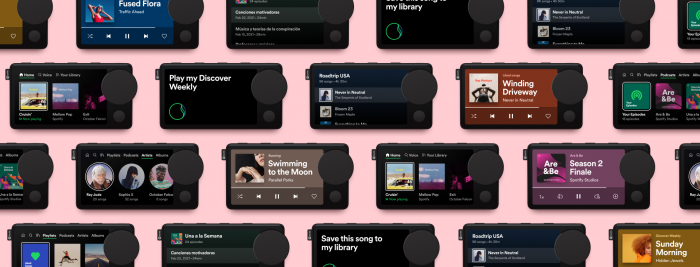Spotify officially launch Car Thing, their in-car music and podcast player
Image Credit: Spotify
After years of prototyping and leaks, Spotify finally announce Car Thing, the streaming company’s smart player for the car, and it’s free… sort of.
Last week, we reported on leaked renders of Spotify’s Car Thing found in the code of the Spotify app. Spotify confirmed they were working on the device over two years ago. After years of development, prototypes, design changes and FCC filings, yesterday Spotify officially launched Car Thing – yep, they’re sticking with that name for now. This is the first hardware device from the streaming company. You may even be able to get your hands on one, free of charge.
Car Thing comes at the perfect time, just as many business around the world are reopening their doors and many are back on the daily commute. Streaming services have changed the way we access music everywhere, including the car. Spotify say there are over 70 million user-generated driving-related playlists, plus almost 10 million followers on their curated Songs to Sing in the Car playlist, and have seen success with Daily Drive, their personalised playlist with music and news.
With Spotify’s full catalogue of music and podcasts, the smart player gives users fast and easy access to music, new, entertainment, talk and more. Car Thing can be controlled via voice, touch or physical control. Four microphones along the top of the device are listening out for the “Hey Spotify” wake word. Spotify will understand all the usual commands such as “Hey Spotify, shuffle my discover weekly”, “Hey Spotify, show similar artists” and so on. Spotify say it’ll hear you even with the music up and windows down. The touch screen works in a similar way to the mobile app, with swipes to browse or skip, and tap to play. The large dial can help you browse, select, play, pause and discover music without touching the screen. Four physical buttons across the top are customisable shortcuts for quick access to your favourites, whether that’s the latest podcast episode or up-to-date news.
Spotify states their focus is still “on becoming the world’s number one audio platform—not on creating hardware”. They built Car Thing to provide a seamless and personalised in-car listening experience for all verhicles, that is intended to work alongside existing in-car infotainment systems.
Here’s how it works (from Spotify):
- Use voice control for easy access. Spotify’s voice search lets you quickly play specific music or podcasts, and can even help you find something new. Just say “Hey Spotify,” then ask for a song, album, artist, playlist, station, or podcast. With four microphones along the top, Car Thing can understand what you’re asking to play, even with the music turned up or your windows down.
- Try the dial for a hands-on way to steer to the audio you love. You can also browse deeper, curating the perfect soundtrack to wherever you’re headed. Use the dial to browse, select, play, pause, and discover.
- View the touch-screen display to see what’s playing. You can also use the screen to see what’s in your library, as well as results from voice search. Swipe to browse further or skip, or tap to play.
- Choose four preset buttons to get to your favorites faster and then change them anytime. They’ll always bring you the newest podcast episodes and up-to-date news.
Spotify’s Car Thing requires a Spotify Premium subscription and mobile data connection, so you’ll need to use your smartphone as a WiFi hotspot.
Car Thing is launching with a limited release to eligible US users. The application is currently invite-only, but you can join the waiting list at carthing.spotify.com. For those luck enough to be selected, Car Thing is free, excluding a $6.99 shipping cost to continental US. The anticipated retail price according to Spotify will be $79.99. We’ll have to wait until Car Thing lands in the hands of consumers to know exactly how “simple and seamless” the interface is. Many infotainment systems, especially those in older cars are slow and unresponsive.

